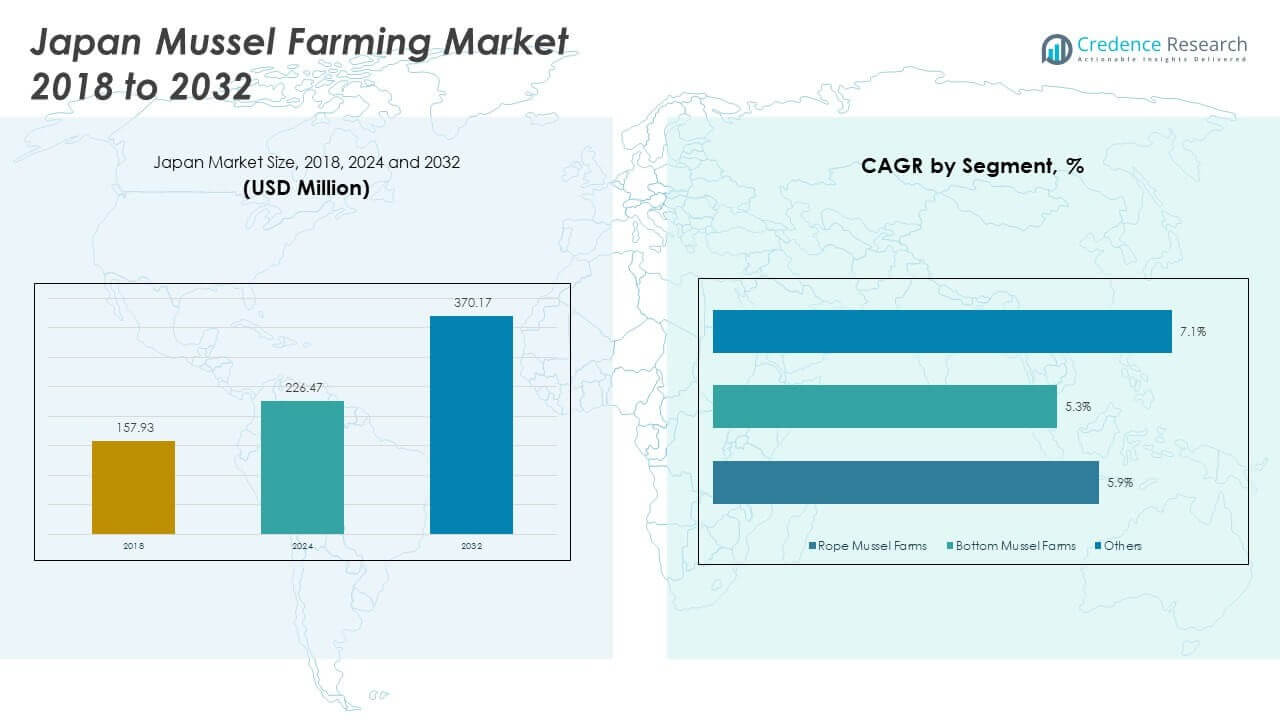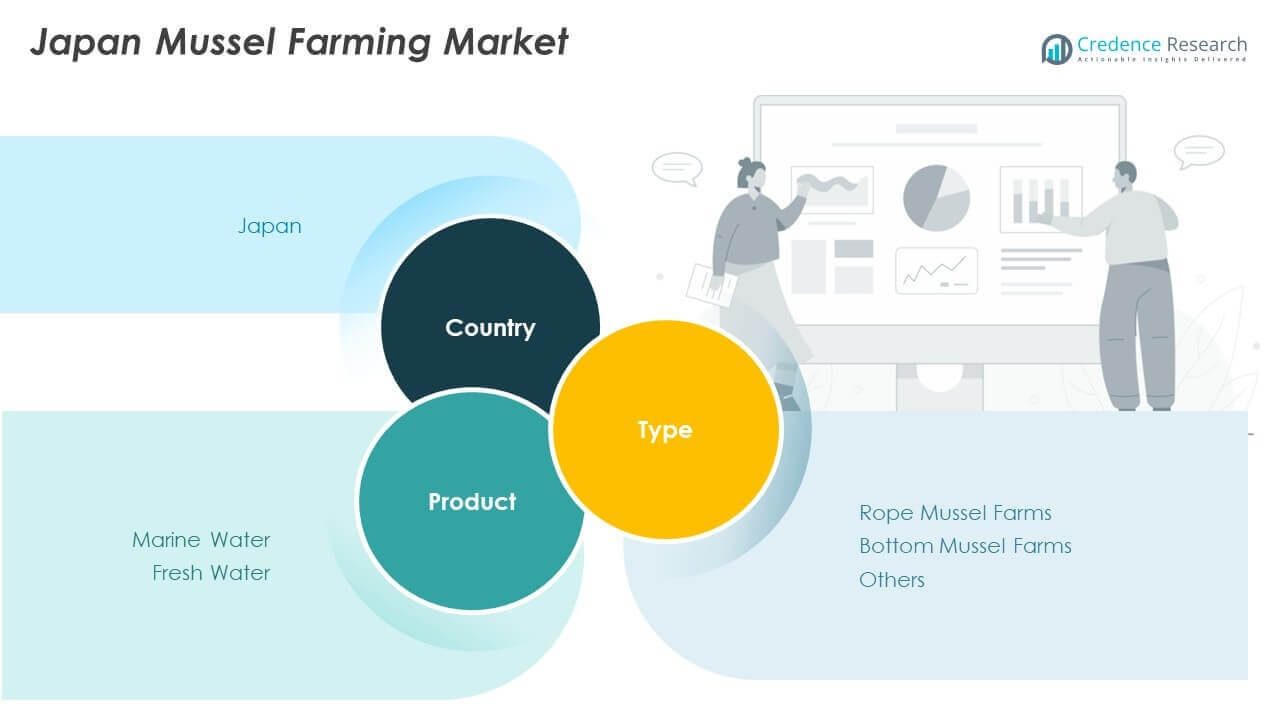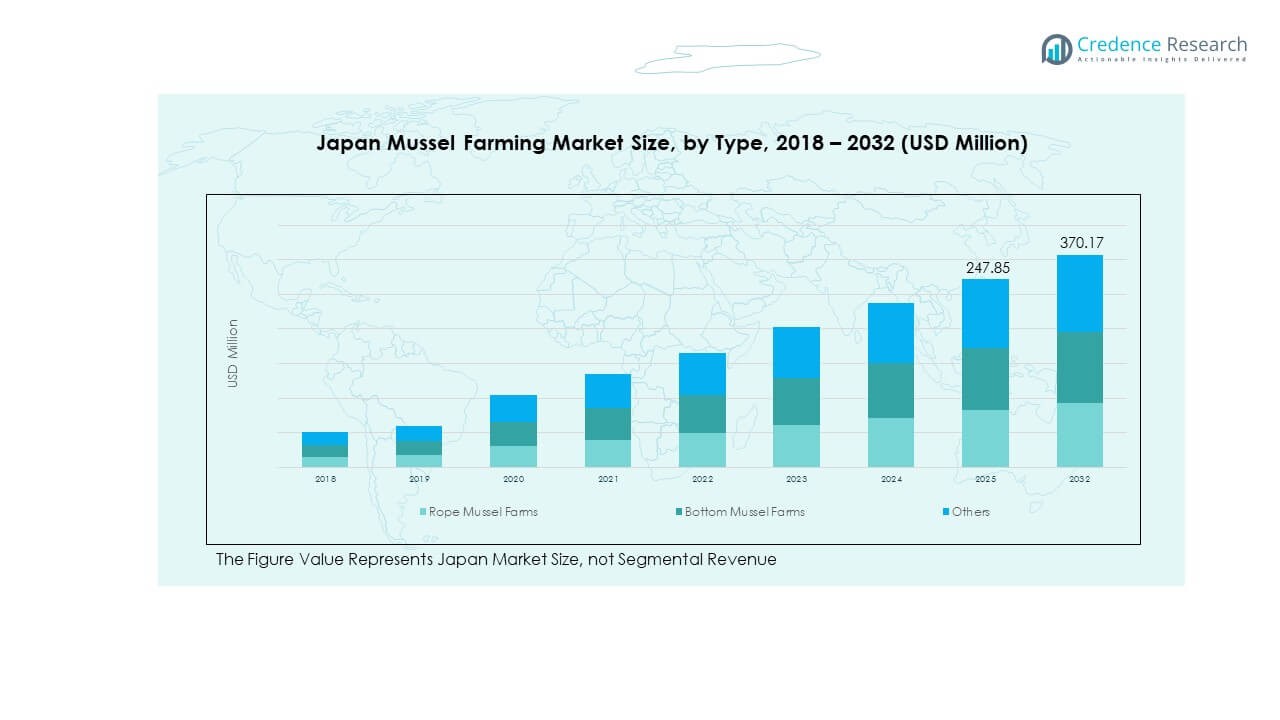Market Overview:
The Japan Mussel Farming Market size was valued at USD 157.93 million in 2018 to USD 226.47 million in 2024 and is anticipated to reach USD 370.17 million by 2032, at a CAGR of 5.90% during the forecast period.
| REPORT ATTRIBUTE |
DETAILS |
| Historical Period |
2020-2023 |
| Base Year |
2024 |
| Forecast Period |
2025-2032 |
| Japan Mussel Farming Market Size 2024 |
USD 226.47 Million |
| Japan Mussel Farming Market, CAGR |
5.90% |
| Japan Mussel Farming Market Size 2032 |
USD 370.17 Million |
Growing awareness of the nutritional value of mussels, including their high protein and omega-3 content, supports strong domestic demand. The food service sector, especially restaurants specializing in seafood, plays a critical role in sustaining this growth. Export opportunities are also emerging due to global demand for high-quality Japanese seafood. The sector benefits from advanced hatchery technology, which enhances yields and reduces losses.
Japan’s regional coastline creates favorable conditions for mussel cultivation. Coastal prefectures such as Hokkaido and Miyagi are leading producers, supported by strong fishing traditions. Emerging prefectures are now adopting mussel farming to diversify income sources. This regional spread ensures a steady increase in production capacity and reduces dependency on imports. The broader Asia-Pacific region is also opening trade avenues, positioning Japan competitively.

Market Insights:
- The Japan Mussel Farming Market was valued at USD 157.93 million in 2018, reached USD 226.47 million in 2024, and is projected to attain USD 370.17 million by 2032, growing at a CAGR of 5.90%.
- Asia Pacific held 42% share, Europe accounted for 27%, and North America secured 18%, driven by established aquaculture infrastructure, seafood consumption, and strong trade networks.
- Latin America recorded 6% share but is the fastest-growing region, supported by coastal resource availability and rising seafood export initiatives.
- Rope mussel farms represented about 62% of the market in 2024, leading due to higher yields and efficiency.
- Bottom mussel farms contributed around 25%, while the remaining 13% came from other smaller-scale or niche farming methods.
Access crucial information at unmatched prices!
Request your sample report today & start making informed decisions powered by Credence Research Inc.!
Download Sample
Market Drivers:
Rising Domestic Seafood Demand and Health-Conscious Consumer Preferences:
The Japan Mussel Farming Market benefits from rising demand for protein-rich seafood among consumers. Health-focused diets are fueling preference for mussels due to their low-fat and nutrient-dense profile. Retailers and restaurants continue to highlight mussels as sustainable protein alternatives, expanding their reach in domestic markets. Government awareness campaigns emphasizing healthy eating further strengthen the trend. Export markets in Asia and Europe also value Japan’s quality standards, providing added opportunities. These developments create a robust foundation for growth and sustainability.
- For instance, Health-focused diets promote mussels for their low-fat, nutrient-dense profile, aligning with trends seen in other seafood sectors where convenience and health benefits drive growth. Retailers and restaurants are emphasizing mussels as sustainable protein alternatives, supported by government awareness campaigns on healthy eating, fueling a further rise in domestic consumption.
Expansion of Sustainable Aquaculture and Hatchery Advancements:
Innovation in aquaculture practices is a strong driver for the Japan Mussel Farming Market. Hatchery technology reduces reliance on wild spat collection and ensures stable production cycles. Automation and advanced monitoring systems are lowering operational risks while improving yields. Producers are adopting eco-friendly farming to meet sustainability certifications, enhancing market credibility. Integration of environmental monitoring protects ecosystems while supporting industry expansion. Such practices reassure global buyers of Japan’s responsible aquaculture standards, supporting both domestic and international growth prospects.
- For instance, Automation and advanced monitoring systems reduce operational risks and improve yields, while eco-friendly farming practices are particularly significant for securing sustainability certifications, thereby enhancing market credibility.
Increasing Export Potential in Asia-Pacific and Beyond:
Japan’s seafood exports remain a core driver of mussel farming growth. Rising demand for premium Japanese seafood in markets such as China, South Korea, and Singapore encourages investments in scaling production. Trade partnerships with European countries also strengthen export potential. Quality assurance standards and strong brand recognition of Japanese aquaculture attract global buyers. Logistics advancements, including cold chain infrastructure, reduce spoilage risks in long-distance shipments. Export-focused strategies create revenue diversity for producers, shielding them from domestic fluctuations.
Government Support and Coastal Infrastructure Development:
The Japan Mussel Farming Market gains momentum from government-led initiatives promoting fisheries and aquaculture. Subsidies, training programs, and research funding improve farming techniques. Infrastructure upgrades in coastal prefectures expand capacity and access to marine resources. Local authorities encourage community-based aquaculture projects, enhancing rural employment opportunities. Regulatory frameworks also support long-term resource sustainability, ensuring ecological balance. Combined, these factors create a favorable environment for long-term growth and industry resilience.
Market Trends:
Adoption of Digital Aquaculture and Smart Monitoring Systems:
The Japan Mussel Farming Market is witnessing a trend of digitization in aquaculture practices. Producers deploy smart sensors and AI-based tools to track water quality, feeding efficiency, and mussel health. Data-driven decisions reduce losses while boosting yields. Blockchain systems are also being explored to ensure transparency in supply chains, strengthening consumer trust. These innovations streamline operations, cut costs, and enhance sustainability outcomes.
- For instance, Blockchain applications are being explored to improve supply chain transparency and strengthen consumer confidence. Such digital innovations contribute to streamlined operations, cost reduction, and improved sustainability outcomes.
Rising Popularity of Value-Added Mussel Products:
Demand for processed and value-added mussel products is rising across Japan. Consumers seek ready-to-cook and convenience-focused seafood items, driving product innovation. Producers are introducing frozen, canned, and packaged mussel products to meet urban demand. Exports of value-added items also expand profitability. Branding and premium packaging help position mussels as gourmet seafood for both domestic and global buyers. This diversification enhances revenue streams and market competitiveness.
- For instance, Producers respond with frozen, canned, and packaged mussel goods that cater especially to urban consumers seeking convenience. The increase in exports of value-added products further boosts market profitability. Strategic branding and premium packaging position mussels as gourmet products, enhancing Japan’s competitiveness domestically and globally.
Focus on Eco-Certifications and International Standards:
Sustainability certifications are emerging as key trends in the Japan Mussel Farming Market. Producers aim to align with international standards such as MSC (Marine Stewardship Council) to secure export opportunities. Certification increases consumer confidence, especially in environmentally conscious markets. Eco-labeled products attract premium pricing, benefiting producers who adopt sustainable farming. Compliance also supports long-term ecosystem preservation, balancing profitability with responsibility.
Collaboration Between Fisheries and Research Institutions:
The market benefits from stronger collaboration between aquaculture firms and research institutions. Universities and fisheries agencies support R&D on improved feed, disease resistance, and farming methods. Pilot projects test innovative techniques before commercial adoption. Knowledge-sharing platforms strengthen industry capabilities. This synergy boosts production efficiency, supports innovation, and ensures that the market remains globally competitive.
Market Challenges Analysis:
Environmental Vulnerability and Climate Change Impact:
The Japan Mussel Farming Market faces significant challenges due to environmental changes. Rising sea temperatures and ocean acidification threaten mussel growth and survival rates. Natural disasters such as typhoons further disrupt farming cycles and damage infrastructure. Producers must invest in adaptive technologies, increasing operational costs. Environmental uncertainties also create risks for export commitments, reducing global competitiveness. Managing these risks requires substantial innovation and government support.
Regulatory Barriers and Labor Shortages in Coastal Regions:
Regulatory compliance remains a major challenge for the Japan Mussel Farming Market. Strict licensing requirements, environmental regulations, and quality standards increase operational complexity. Small-scale farmers often face difficulties in meeting these requirements, limiting scalability. Additionally, labor shortages in coastal regions reduce production efficiency. Younger populations are moving away from traditional fisheries, creating generational gaps. These factors slow expansion and limit industry resilience against global competitors.

Market Opportunities:
Expansion into Value-Added Seafood Exports:
The Japan Mussel Farming Market offers opportunities in the development of value-added exports. Global demand for premium Japanese seafood presents strong avenues for growth. By offering processed mussel products, producers can capture higher margins. Growing consumer focus on convenience and nutrition supports this trend. Expansion into neighboring Asia-Pacific markets provides scale and long-term profitability.
Investment in Sustainable and Digital Farming Practices:
There is a strong opportunity for producers to integrate sustainable and digital farming systems. AI-driven monitoring, eco-certifications, and efficient hatcheries can enhance yields. These investments support domestic demand while opening global trade opportunities. Adopting advanced technologies also secures competitive positioning against international players.
Market Segmentation Analysis:
By Type
The Japan Mussel Farming Market is segmented into rope mussel farms, bottom mussel farms, and others. Rope mussel farms dominate due to their efficiency and suitability for coastal environments. They allow higher yields, consistent quality, and lower operational risks. Bottom mussel farms contribute to regional production where seabed farming conditions are favorable. The “others” category includes experimental and small-scale methods that serve niche markets. Together, these farming types balance large-scale production with regional adaptability, supporting stable growth and diversification.
- For instance, rope mussel farms dominate the market due to their efficiency, high yields, and suitability for coastal environments, which constitute the majority of Japan’s extensive coastline. Bottom mussel farms also contribute significantly where seabed conditions permit. Together, these methods balance large-scale production with regional adaptability.
By Product
By product, the Japan Mussel Farming Market is divided into marine water and fresh water. Marine water farming holds the majority share, benefiting from Japan’s extensive coastline and favorable marine ecology. It supports large-scale cultivation, catering to both domestic and export demand. Freshwater farming, though smaller in scale, is gaining importance in selected inland regions. It provides an alternative supply source while diversifying production bases. This segmentation demonstrates how Japan leverages its natural resources to meet rising seafood demand while ensuring production resilience.
- For instance, Freshwater farming, though smaller, grows in selected inland regions, contributing to a diversified and resilient production base aligned with Japan’s natural resources and rising seafood demand.

Segmentation:
By Type
- Rope Mussel Farms
- Bottom Mussel Farms
- Others
By Product
Regional Analysis:
Hokkaido
Hokkaido is the leading region in the Japan Mussel Farming Market, supported by its cold and nutrient-rich waters. The area provides optimal conditions for rope mussel farms, which dominate production. Its long coastline and advanced hatchery systems ensure consistent supply and high-quality yields. Exports from Hokkaido enjoy strong demand in Asia and Europe due to premium standards. Local government programs encourage sustainable aquaculture practices, further enhancing market credibility.
Miyagi
Miyagi Prefecture contributes significantly through the adoption of modern rope farming methods and hatchery investments. Producers in the region focus on stabilizing seed supply and increasing output efficiency. Its strategic location along the Pacific coast supports large-scale distribution to both domestic markets and export destinations. The prefecture also benefits from government-backed coastal development projects. Strong industry collaborations and technical advancements reinforce its role in Japan’s mussel farming sector.
Aomori
Aomori serves as a growing contributor within the Japan Mussel Farming Market. Favorable coastal waters and supportive local policies encourage expansion of mussel cultivation. Smaller farms dominate, but they play a vital role in regional food supply chains. Aomori emphasizes diversification by combining mussel farming with other aquaculture products. The prefecture is steadily increasing its production base to capture rising domestic demand.
Domestic Consumption and Trade
Japan’s metropolitan centers, including Tokyo and Osaka, represent the largest consumers of mussels. Demand is driven by restaurants and retail outlets highlighting mussels as premium seafood. Government policies on aquaculture sustainability and eco-certification strengthen Japan’s international reputation. Export strategies target South Korea, China, and Europe, where buyers value eco-labeled, high-quality mussels. This balance between domestic demand and export growth positions Japan as a strong leader in mussel farming.
Shape Your Report to Specific Countries or Regions & Enjoy 30% Off!
Key Player Analysis:
Competitive Analysis:
The Japan Mussel Farming Market features moderate competition shaped by established aquaculture companies and regional producers. Leading firms focus on sustainable farming practices, product diversification, and value-added offerings to strengthen their market presence. Strong domestic demand, coupled with rising export opportunities, fuels competition among both large-scale and small-scale operators. Innovation in hatchery technologies and cold chain infrastructure supports long-term growth. It continues to attract new entrants due to supportive government policies and consumer preference for premium seafood. Competitive positioning depends on quality, sustainability credentials, and reliable distribution networks. Established players leverage brand reputation, while regional producers target niche markets. The Japan Mussel Farming Market reflects a balance of consolidation and regional diversity, creating a dynamic competitive landscape.
Recent Developments:
- In 2025, Ogawa & Co., Ltd. continued its commitment to enriching society with essential oils, extracts, flavors, and fragrances through close partnerships with municipalities and companies to promote development, manufacturing, and sales of products utilizing Japanese agricultural, forestry, and fishery offerings, though no specific mussel product launch or acquisition was found.
Report Coverage:
The research report offers an in-depth analysis based on type and product segments. It details leading market players, providing an overview of their business, product offerings, investments, revenue streams, and key applications. Additionally, the report includes insights into the competitive environment, SWOT analysis, current market trends, as well as the primary drivers and constraints. Furthermore, it discusses various factors that have driven market expansion in recent years. The report also explores market dynamics, regulatory scenarios, and technological advancements that are shaping the industry. It assesses the impact of external factors and global economic changes on market growth. Lastly, it provides strategic recommendations for new entrants and established companies to navigate the complexities of the market.
Future Outlook:
- Rising seafood consumption will continue to strengthen domestic demand.
- Export opportunities in Asia-Pacific and Europe are expected to expand.
- Rope mussel farms will remain the dominant farming method.
- Marine water cultivation will hold the largest share of production.
- Eco-certification and sustainability practices will gain higher adoption.
- Digital aquaculture technologies will improve efficiency and monitoring.
- Cold chain infrastructure investments will reduce post-harvest losses.
- Government support will promote rural employment and coastal development.
- Value-added mussel products will grow in popularity among urban consumers.
- Collaborations between research institutions and producers will drive innovation.






